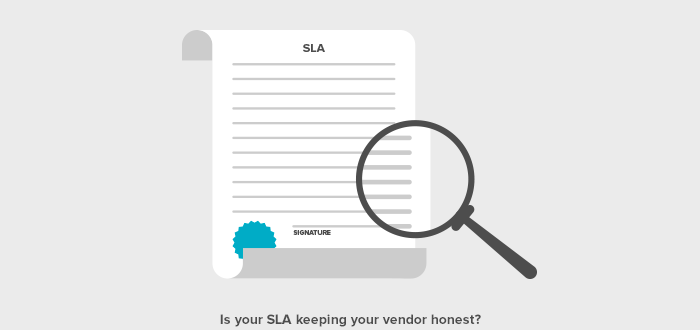In telecom, as with most other service based industries, when you work with a vendor you enter into a Service Level Agreement (SLA). The purpose of the SLA is to establish the terms of service and the responsibilities of the vendor to supply defined parameters of availability, giving you, the customer, assurance of when the service will be available for use. But also a variety of other commitments.

Availability is measured by the percentage of the period that you have access to the service (uptime).
Availability % |
Downtime/year |
Downtime/month |
Downtime/day |
|---|---|---|---|
| 99.9% (“three nines”) | 8.76 hours | 43.8 minutes | 10.1 minutes |
| 99.99% (“four nines”) | 52.56 minutes | 4.32 minutes | 1.01 minutes |
| 99.999% (“five nines”) | 5.26 minutes | 25.9 seconds | 6.05 seconds |
| 99.9999% (“six nines”) | 31.5 seconds | 2.59 seconds | 0.605 seconds |
| 99.99999% (“seven nines”) | 3.15 seconds | 0.259 seconds | 0.0605 seconds |
Agreements will most likely make a commitment of how many “nines” the vendor is expected to provide. The level of uptime you should look for will depend on the criticality of the service. For phone service, three nines might be acceptable. But for financial transactions, you may require five nines or more. It really depends on your specific needs and how much unavailability your business is able to tolerate.
SLAs aren’t meant to cripple vendors, that would not be in either party’s best interest. And a missed agreement does not necessarily get the customer out of a contract. In essence, SLAs are a sales tool meant to provide the customer with a level of comfort that the vendor bears an incentive for providing the agreed upon service. This incentive often comes in the form of a credit supplied to the customer in the event the vendor fails to meet the level of service promised by the SLA.
E.G. A customer may be credited for downtime that drops availability below the stated commitment. Simplistically, if a service outage lasts 15 minutes, and the agreement dictates 99.999 availability, the vendor owes the customer a credit as stated in the SLA.
Typically an SLA will provide stipulations on exactly how much downtime must occur before a credit is owed and how much credit will be applied, so read the fine print. The idea behind the credit is that it provides enough of a sting to keep the vendor paying attention.
Here’s where customers need to pay attention.
You don’t want a credit to be your exclusive remedy in the event of a vendor breach. If you are locked in to a contract with a vendor for three years and halfway through year one you’re stifled by 50% uptime, you won’t want a credit, you’ll want out. Massive failure should breach your contract. So make sure that language is included in the SLA before you sign it.
Be suspicious of language like this:
Any remedies available to Customer in the SLA shall be the exclusive remedies available to Customer for any failure of Vendor to provide the Service in accordance with the SLA.
That particular verbiage was tucked away in a paragraph on an SLA we recently received from a vendor (whose name we’ve redacted). At first glance, it seems harmless enough, no legalese to sound the alarm for closer inspection. But the words establish limits on the customer when it comes time to collect damages for missed service levels, and even strengthens the vendor’s position by implying there is no circumstance under which the contract may be cancelled due to a service level breach.
Make sure your SLA allows for cancellation of your contract in the face of significant service level failures, either by stipulating precisely at which point the vendor has completely failed to live up to their end of the bargain or by not limiting your options to account credit. Pay attention to what it is the vendor is actually putting on the line.
Exemptions are another aspect of SLAs to watch closely.
Regularly scheduled downtime is a very normal and positive thing. You want your service providers to maintain the platforms on which they provide service.
But because you are employing their service for the day to day functioning of your business, you need to make sure downtime for maintenance is predictable and won’t interfere with your schedule. Ask questions like; Is there a limit to scheduled maintenance? and, Is the schedule convenient for my business?
It’s entirely reasonable to ask for revisions to your vendor’s maintenance schedule if it doesn’t work for you.
An SLA is pointless if the claims process is unmanageable.
What happens if your vendor fails to meet the terms of your SLA? Is credit automatic, or are you required to monitor your service 24/7 and file a claim through a cumbersome procedure?
The process following a breach of SLA is important because if you are required to jump through a series of unrealistic hoops, the agreement is essentially worthless. Be clear about who is responsible for tracking service, and establish deadlines for compensation.
An SLA goes beyond reputation.
Service level agreements should be in place to keep your vendors honest and motivated beyond maintaining a trustworthy reputation. To be meaningful, promises need to be appropriate for the service being provided, i.e. a telco that commits to 80% uptime isn’t committing to anything meaningful.
Take the time to read through any SLAs. Make sure your vendor is on the hook for real consequences in the event of a failure while still being able to provide you service. The SLA should be worded more in favor of protecting the customer, rather than giving the vendor an excuse to drop their end of the bargain.
Disclaimer: This post’s contents are for informational purposes only, are not legal advice and do not create an attorney-client relationship. Always consult with competent local counsel on any issues discussed here.






